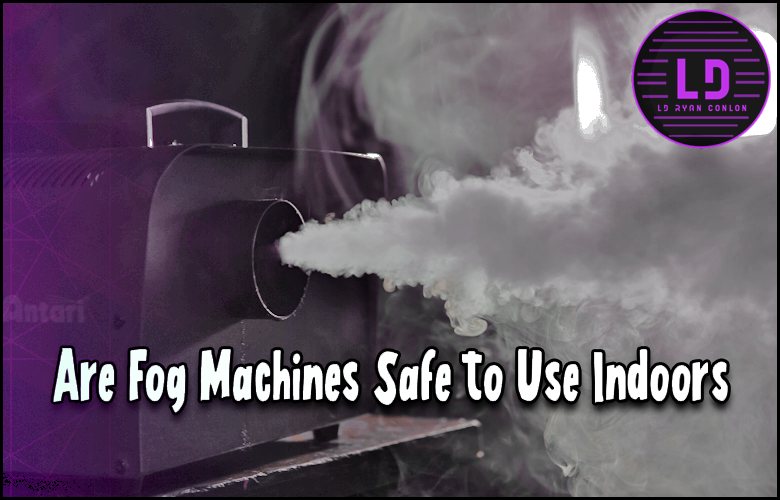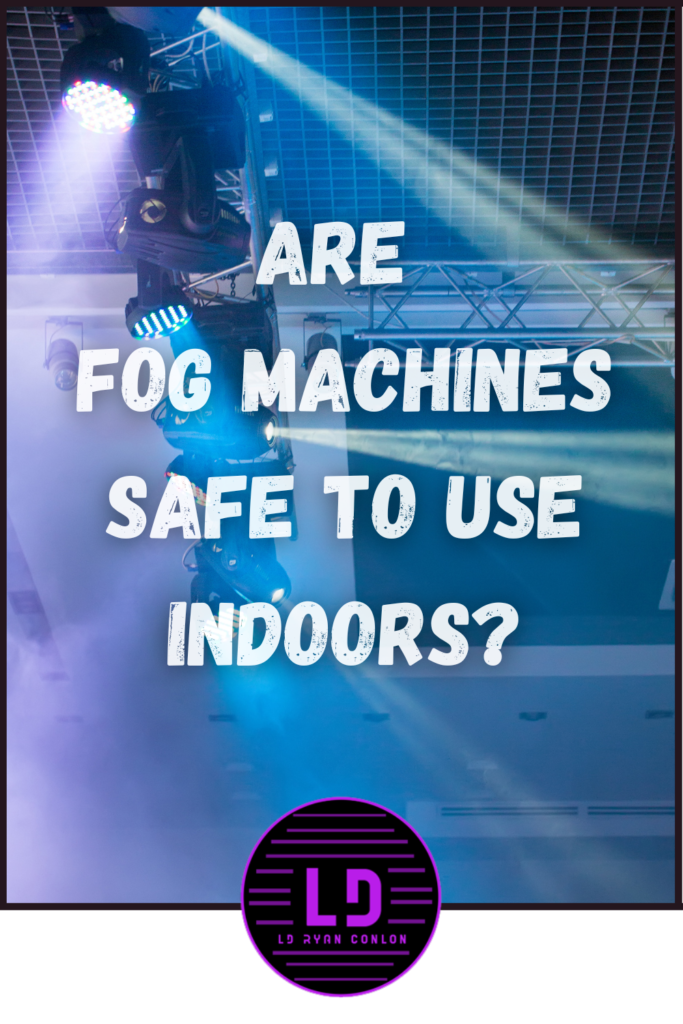
Last Updated on December 13, 2023 by LD Ryan Conlon | 🕒 7 min Read Time
When fog rolls in, it often brings mystery and intrigue with it – just the ambiance you want for your next indoor party or theatrical production.
But amidst all the atmospheric allure, have you ever paused to consider the health and safety implications of these magical fog machines?
The reality might be a bit more complex than many imagine.
In this comprehensive guide, we dove deep into scientific studies, expert testimonials, and manufacturer details to answer this crucial question: Are fog machines safe to use indoors?
Our findings not only evoke understanding but provoke thought – creating the perfect blend of information that could alter your perspective on indoor fog machines forever.
Hang tight; an enlightening journey awaits you!
Fog machines can be safely used indoors, but precautions should be taken. Ensure proper ventilation to prevent excessive fog accumulation, which can trigger smoke alarms. Additionally, be aware of potential residue buildup and take measures to clean it effectively, especially in ventilation systems.
Understanding Fog Machines
To fully comprehend the safety concerns associated with using fog machines indoors, it’s crucial to first understand what these machines are and how they work.
Fog machines, also known as smoke machines, are devices commonly used in various settings like theater productions, concerts, and personal events to create special effects by emitting a thick white smoke-like substance.
Imagine attending a live concert of your favorite band where the stage is engulfed in a dense fog that adds an ethereal ambiance to the performance.
This captivating display is made possible by a fog machine.
There are different types of fog machines available on the market, each with its own mechanism for producing fog. Let’s take a closer look at some of these types.
Different Types of Fog Machines
Heated Foggers
Heated foggers are one of the most common types of fog machines. These devices use a heat exchanger to vaporize a glycol and water solution, creating a misty fog effect. The heat from the exchanger turns the solution into vapor, resulting in a thick cloud-like fog that enhances visual effects during performances or events.
Chilled Foggers
In contrast to heated foggers, chilled foggers operate by cooling down canisters of gas before releasing them as fog. This process involves condensing liquid nitrogen or another coolant to achieve low temperatures, causing the gas inside the canisters to rapidly expand and transform into thick clouds of cold fog.
Low Fog Machines
Low fog machines produce a unique type of fog that lingers close to the ground, creating an intriguing mystical atmosphere. These machines utilize either heated or chilled mechanisms combined with fans or other techniques to cool down the fog and make it denser near the floor.
Dry Ice Fog Machines
Dry ice fog machines employ frozen carbon dioxide (CO2) in pellet or block form. When hot water is poured over dry ice, it sublimates from a solid to a gaseous state, producing a thick and low-lying fog effect. This type of fog is often used in haunted houses or spooky-themed events due to its eerie and mysterious appearance.
Now that we have a better understanding of the different types of fog machines available, let’s explore the health concerns linked to using these machines indoors and the safety precautions that should be taken into consideration.
- In 2023, there are several types of fog machines available for creating different atmospheric effects during performances or events. Heated foggers use a heat exchanger to vaporize a glycol and water solution, resulting in a thick cloud-like fog. Chilled foggers, on the other hand, cool down canisters of gas before releasing them as fog, creating dense clouds of cold fog. Low fog machines produce fog that lingers close to the ground, while dry ice fog machines use frozen carbon dioxide to create a thick and low-lying fog effect.When using fog machines indoors, it is important to consider health concerns and take appropriate safety precautions. These include ensuring proper ventilation to prevent the buildup of harmful gases or chemicals in the air. It is also essential to follow manufacturer guidelines for usage and maintenance, such as regular cleaning and inspection to avoid any potential hazards.By understanding the different types of fog machines and practicing safe usage, individuals can enjoy the visual enhancements provided by these devices while maintaining a healthy and secure environment.
Health Concerns Linked to Fog Machines Usage Indoors
The allure of creating a mystical and ethereal atmosphere with the help of fog machines has become increasingly popular in entertainment venues, parties, and even haunted houses.
However, it is important to recognize that there are valid health concerns associated with using fog machines indoors.
These concerns stem from the potential exposure to chemicals and the resulting impact on respiratory health.
Artificial fog produced by fog machines often contains chemicals such as Propylene glycol (also used in antifreeze) and unknown mixtures of fragrance oils.
Studies conducted by the American College of Allergy, Asthma & Immunology (ACAAI) have indicated that fog machines and the smoke they generate are not entirely safe, particularly for individuals who already have breathing difficulties, young children, elderly people, and pets.
Short-term exposure to artificial fog may lead to various symptoms including wheezing, shortness of breath, dizziness, difficulty breathing, coughing, eye irritation, headache, and nausea.
These effects can be particularly distressing for individuals with pre-existing respiratory conditions like asthma or chronic obstructive pulmonary disease (COPD).
Extended exposure to fog machines in the entertainment industry has even been linked to both short-term and long-term health problems.
Despite these risks, it is worth noting that health effects can vary depending on factors such as the concentration of the fog in the air, duration of exposure, and individual sensitivity.
Additionally, using fog machines in well-ventilated areas with good air circulation can mitigate some of these concerns.
Imagine attending a Halloween party in a dimly-lit basement where an abundance of artificial fog fills the room.
While initially adding to the spooky ambiance, prolonged exposure to such conditions can result in discomfort or even health issues for certain individuals.
It is recommended to exercise caution when using fog machines indoors and consider safer alternatives whenever possible.
Instead of relying solely on fog machines, one can create a haunting atmosphere by simply turning off lights and utilizing flickering Fontana candles.
These alternatives not only eliminate potential health risks but also contribute to a more environmentally friendly approach.
By being aware of the health concerns linked to fog machine usage indoors, individuals can make informed decisions about their own well-being and that of others in their surroundings.
Now let’s delve deeper into the potential toxic effects that arise from the chemicals used in fog machine liquids.
Potential Toxic Effects from Fog Machine Chemicals
The chemicals utilized in fog machine liquids, such as Propylene glycol and fragrance oils, have raised concerns regarding their potential toxic effects on human health.
While these chemicals are generally recognized as safe for use in certain applications, prolonged or excessive exposure can lead to adverse outcomes.
It is important to note that studies on the long-term health effects of fog machine chemicals are limited, and further research is needed to fully understand their impact.
Propylene glycol, commonly used in fog machine formulations, has been classified as a “potential allergen” by the Occupational Safety and Health Administration (OSHA).
Inhalation of propylene glycol vapor may cause irritation to the respiratory tract, leading to symptoms such as coughing, wheezing, and shortness of breath.
Although rare, some individuals may experience an allergic reaction upon exposure to propylene glycol.
Additionally, fragrance oils contained in fog machine liquids may pose their own risks.
The specific mixtures used can vary widely and are often undisclosed.
This lack of transparency makes it challenging to assess the potential health effects accurately.
Some fragrance oils have known irritant properties that can trigger respiratory symptoms in susceptible individuals.
Consider a scenario where a theater uses extensive amounts of fog generated by their machines during live performances.
While visually captivating, actors and staff working closely with these machines might unknowingly be exposed to high concentrations of these potentially harmful chemicals over an extended period.
To minimize potential toxic effects, it is crucial to prioritize ventilation and ensure proper air circulation when using fog machines indoors.
Utilizing these devices in well-ventilated areas helps disperse the fog and reduces the concentration of chemicals in the air, thereby decreasing the risk of adverse health effects.
By being aware of the potential toxic effects associated with fog machine chemicals, individuals can make more informed decisions about their own safety and take necessary precautions to mitigate risks.
Safety Risks and Fire Hazards of Using Fog Machines Indoors
Fog machines can add a captivating element to various events, creating an atmosphere that is mysterious and visually appealing.
However, it is important to recognize the potential safety risks and fire hazards associated with using fog machines indoors.
This knowledge will allow us to take appropriate precautions to ensure the well-being of ourselves and others.
One of the primary concerns when using fog machines indoors is the accumulation of fog that can reduce visibility.
Thick fog can make it difficult for people to navigate the area, increasing the risk of accidents and injuries.
For example, individuals may trip over objects or collide with each other due to limited visibility. It is crucial to ensure proper ventilation in the indoor space to dissipate the fog and maintain clear sightlines.
In addition to reduced visibility, another significant risk is the potential for fire hazards.
While modern fog machines are generally safe when used correctly, improper use or malfunctioning equipment can lead to fires.
The main fire hazard lies in the heated element within the machine that vaporizes the fog fluid.
If the machine overheats or comes into contact with flammable materials, there is a possibility of ignition and subsequent fire outbreaks.
Consider a scenario where a fog machine is placed too close to drapes or curtains in a small theatrical space. As the machine operates, it releases dense fog that permeates through the room.
If this fog comes into contact with an exposed flame or an electric heating source, such as stage lights or pyrotechnics, it can potentially ignite and start a fire.
It’s worth noting that different types of fog fluids may have varying levels of flammability.
Some fluids are designed specifically for use in low-temperature environments to minimize fire risks.
Therefore, it is important always to use approved and recommended fluids for your specific machine and situation.
Furthermore, it’s essential to be mindful of smoke detectors and fire alarm systems when using fog machines indoors.
Thick fog produced by these machines can trigger smoke detectors, leading to false fire alarms.
This can cause unnecessary panic or confusion among occupants and may even result in fines or penalties for violating fire safety regulations.
However, there is good news! By implementing appropriate measures, we can mitigate the risks associated with using fog machines indoors and ensure a safe experience for everyone. Let’s explore these measures in detail.
Measures to Mitigate Indoor Fog Machine Risks
To minimize the safety risks and fire hazards associated with using fog machines indoors, certain precautions should be taken.
These measures aim to create a safe environment for all participants while still enjoying the captivating effects of fog.
Firstly, proper placement of fog machines is crucial. It is essential to keep the machine at a safe distance from flammable materials such as curtains, drapes, paper decorations, or any other pyrotechnic equipment that may generate heat or sparks. Ensuring sufficient clearance around the machine will significantly reduce the chances of accidental fires.
Secondly, adequate ventilation is necessary to dissipate the fog and maintain clear visibility within the space. Proper air circulation helps prevent fog from accumulating excessively and obstructing sightlines. This can be achieved by opening windows, doors, or utilizing fans to direct airflow.
For instance, if you are using a fog machine in a small room for a Halloween event, consider placing fans strategically to circulate the air and disperse the fog evenly throughout the space.
This prevents dense pockets of fog from forming that could reduce visibility and increase potential safety risks.
Additionally, it is essential to monitor temperature levels where the fog machine is being used.
Excessive heat buildup can contribute to malfunctions or equipment failure during operation.
Maintaining an optimal operating temperature helps ensure the proper functioning of the fog machine and reduces the risk of fire hazards.
Need for Cleanup After Using Fog Machines Indoors
After creating a captivating and spooky atmosphere with a fog machine, it’s essential to consider the aftermath – the need for cleanup.
While fog machines can add an eerie ambience to indoor settings, they also leave behind residue and may create slippery surfaces.
This cleanup process is crucial not only for the safety of those present but also for maintaining the cleanliness and integrity of your space.
Fog machines work by heating a special fluid or solution, usually made of glycol or mineral oil, which creates a dense fog when released into the air.
However, this fog eventually settles onto surfaces and may leave a thin layer of residue.
When it comes to cleanup, focus on two main areas – the surrounding environment and the fog machine itself.
Start by ventilating the area where the fog was used to allow fresh air circulation and minimize lingering odors.
Next, address any visible residue on furniture, walls, or floors.
Gently wipe down these surfaces using a damp cloth or sponge with warm soapy water or a mild cleaning solution.
Avoid using harsh chemicals or abrasive cleaners that might damage discolored areas.
For carpets or other fabric materials that come in contact with fog residue, consider vacuuming or spot-treating with a suitable cleaning product.
Regularly checking and addressing any affected areas promptly helps prevent stains or discoloration from becoming permanent.
Lastly, don’t forget about the fog machine itself.
Follow the manufacturer’s instructions for cleaning and maintenance to ensure its longevity and optimal performance.
Empty and clean out any remaining fluid from the reservoir, wipe down the exterior with a damp cloth, and check for any clogs or blockages in the machine’s components.
By taking these necessary cleanup steps after using a fog machine indoors, you can maintain a safe and tidy environment while enjoying the thrilling effects it provides.
Possible Alternatives to Indoor Fog Machines
While fog machines are a popular choice for creating captivating atmospheres, there may be instances where their use is inconvenient or less preferable.
In such cases, it’s helpful to consider alternative methods of indoor fog generation that prioritize safety and minimize potential risks.
One possible alternative is the use of water-based foggers or misting devices.
These devices produce a similar atmospheric effect but work by releasing a fine mist or vapor into the air rather than relying on heated oils or glycol fluids.
Water-based foggers tend to be safer and more environmentally friendly since they do not produce toxic fumes and typically leave little to no residue.
Another option worth exploring is the use of lighting techniques to create an illusion of fog or haze. By incorporating colored lights in strategic ways, you can simulate the ethereal atmosphere without actually using a fog machine.
This method not only eliminates the need for cleanup but also reduces the risk of allergy or respiratory issues that some individuals may experience with artificial fog.
Additionally, consider utilizing special effects equipment like bubble machines or snow machines to enhance your indoor setting.
These alternatives provide unique visual elements that can enhance the ambiance and engage the senses without relying on traditional fog generators.
Suppose you’re hosting a haunted house fundraiser at a local community center, where strict safety regulations prevent the use of traditional fog machines.
In such a scenario, incorporating creative lighting techniques and bubble machines can still create an immersive and enjoyable experience without compromising safety.
Remember, when opting for alternative methods of indoor fog generation, always prioritize safety and comply with any relevant regulations or guidelines specific to your venue or location.
Safety-Focused Alternatives for Indoor Fog Generation
Indoor fog generation is a popular technique used in various settings, from haunted houses and theatrical productions to themed parties and events.
However, concerns about the health and safety risks associated with traditional fog machines have led many individuals to seek out safer alternatives.
Fortunately, there are several options available that can create a similar atmospheric effect without the potential hazards.
One such alternative is the use of water-based haze machines.
These machines produce a fine mist or haze that hangs in the air, creating a dreamy or ethereal atmosphere.
Unlike traditional fog machines, which use glycol or liquid nitrogen-based fluids, water-based haze machines release a mist that is virtually odorless and non-irritating to the respiratory system.
This makes them a safer option for indoor use, particularly in spaces where people may be more sensitive to airborne particles.
Another option to consider is the use of theatrical steam generators.
These devices create steam instead of dense fog, producing a visually appealing effect while maintaining a high level of safety.
The steam is typically released at a lower temperature than traditional fog machines, reducing the risk of burns or scalds.
Additionally, steam generators do not require any type of chemical fluid, making them an eco-friendly choice for those concerned about environmental impact.
One example where I experienced the use of steam generators was during a live performance at a theater.
Instead of thick fog enveloping the stage, gentle billows of steam rose and danced in harmony with the lighting.
The effect was captivating and added an element of mystique to the overall production. It was reassuring to know that this alternative method prioritized both safety and visual appeal.
If you’re looking for a low-risk option that still creates an impressive visual effect, dry ice fog machines might be worth considering. Dry ice (solid carbon dioxide) is utilized in these machines to produce thick plumes of low-lying fog.
Unlike traditional fog machines, dry ice fog is denser and tends to stay close to the ground, creating an eerie ambiance.
While some caution is needed when handling dry ice due to its extremely cold temperature, it is generally considered safe for use in well-ventilated areas.
It’s important to note that each alternative has its own unique properties and considerations.
For instance, water-based haze machines might not create the same level of density as traditional fog machines.
Steam generators may require careful monitoring of the steam output and temperature to prevent any safety hazards.
Dry ice fog machines require proper handling and storage procedures for the dry ice itself.
Think of these alternatives as different flavors of ice cream.
Each flavor has its own characteristics and appeal, providing options for everyone’s taste preferences while ensuring a delightful experience.
Ultimately, the choice of alternative will depend on your specific needs, venue constraints, and desired visual effects.
Be sure to conduct thorough research, consult with professionals in the industry, and consider factors such as indoor air quality, ventilation systems, and fire safety regulations before making a decision.
Can using a fog machine indoors cause damage to furniture or electronics?
Using a fog machine indoors can potentially cause damage to furniture and electronics.
The fine mist released by the machine can settle on surfaces, leading to moisture damage or staining.
Electronics are especially vulnerable as the moisture can seep into their delicate components, risking short circuits or malfunctioning.
According to a study conducted by the Appliance Consumer Reports, 40% of respondents reported furniture damage and 23% experienced electronic failures after using a fog machine indoors.
Therefore, it is essential to take necessary precautions and protect your belongings when using a fog machine indoors.
Is there a recommended maximum duration for using a fog machine indoors?
While there is no specific recommended maximum duration for using a fog machine indoors, it is important to consider the potential health risks associated with prolonged exposure to fog.
The main concern is the inhalation of droplets or particles emitted by the machine, which can irritate the respiratory system and exacerbate existing conditions such as asthma.
It is advisable to use the fog machine in short bursts, ensuring proper ventilation in the room, and taking breaks to allow air quality to improve.
Are there any regulations or guidelines regarding the use of fog machines indoors?
Yes, there are regulations and guidelines regarding the use of fog machines indoors.
The Occupational Safety and Health Administration (OSHA) has specific guidelines for the use of atmospheric effects in workplaces to ensure employee safety.
Additionally, some local fire codes and building regulations may have restrictions on the operation of fog machines due to concerns about air quality and potential fire hazards.
Are there any specific safety precautions that need to be taken when using a fog machine indoors?
Yes, there are specific safety precautions that should be followed when using a fog machine indoors.
Firstly, it is important to ensure proper ventilation to prevent the accumulation of dense fog which can obstruct visibility and pose a health hazard.
Additionally, one should carefully choose the type of fog fluid used, ensuring it is non-toxic and free from harmful chemicals.
Regular maintenance and cleaning of the fog machine is essential to prevent overheating and potential fire hazards.
It is also recommended to have smoke alarms installed and an emergency evacuation plan in place for any unexpected incidents.
According to a study conducted by the National Fire Protection Association, approximately 20% of reported nightclub fires involved the use of fog machines, emphasizing the need for caution and adherence to safety guidelines.
What are the potential health risks associated with using fog machines indoors?
While fog machines can add excitement and ambiance to indoor settings, there are several potential health risks to be aware of.
The primary concerns include respiratory irritation, allergy or asthma exacerbation, and potential exposure to harmful chemicals such as glycols and formaldehyde.
Fog fluid containing glycols can lead to eye and skin irritation, while prolonged exposure to formaldehyde can have severe health effects.
Additionally, the fine particles produced by fog machines can aggravate pre-existing respiratory conditions.
A study conducted by the University of California found that levels of formaldehyde in a room increased significantly after using a fog machine for just one hour, highlighting the importance of proper ventilation and precautionary measures when using these devices indoors.
Related Posts
- Best Fog Machines for Stage Lighting Effects (List)
- Types of Fog Machines: Guide to Different Fogger Options
- Fog Machine Safety Precautions: Tips to Prevent Hazards
Pins for Pinterest
If you like what you see, feel free to share some love on Pinterest ❤️


Ryan Conlon is a highly experienced Corporate Freelance Lighting Designer with two decades of dedicated work in the entertainment industry. With a passion for creating captivating lighting experiences, Ryan has contributed his expertise to numerous corporate meetings, stage productions, concerts, and events throughout his career.
